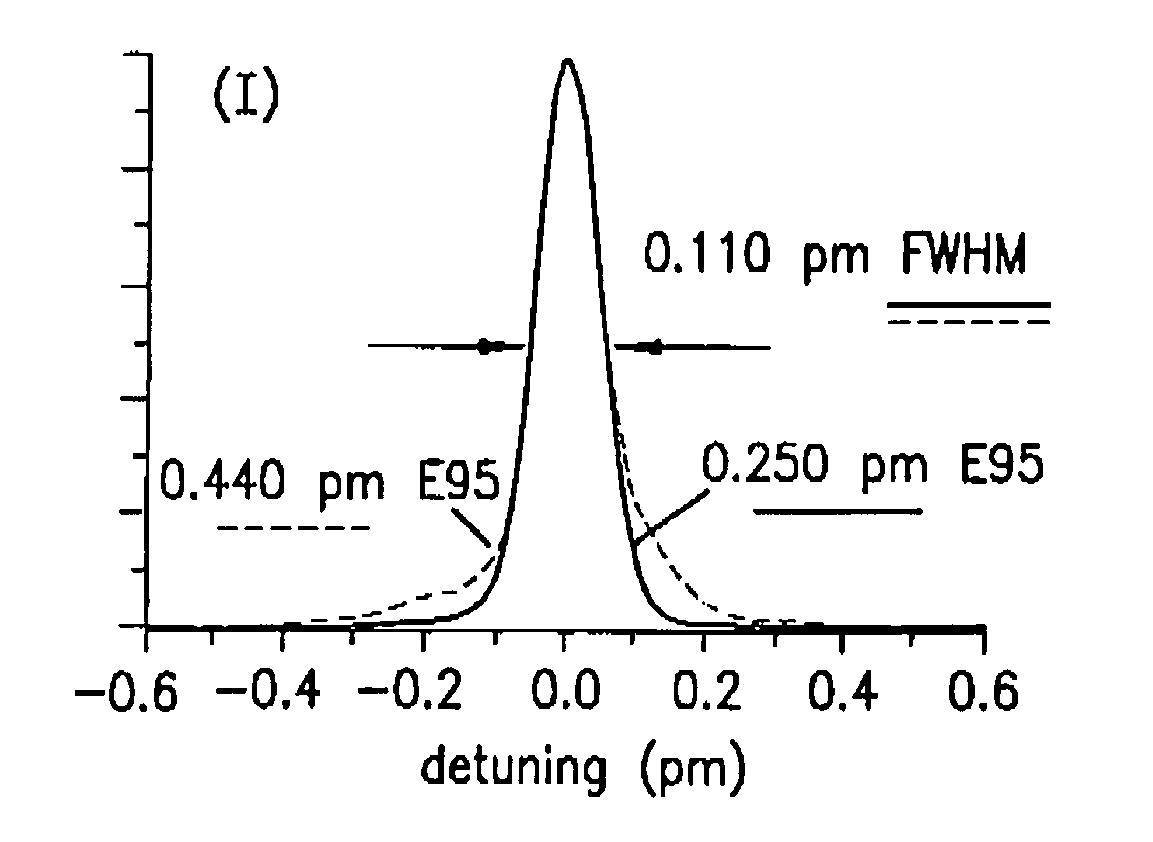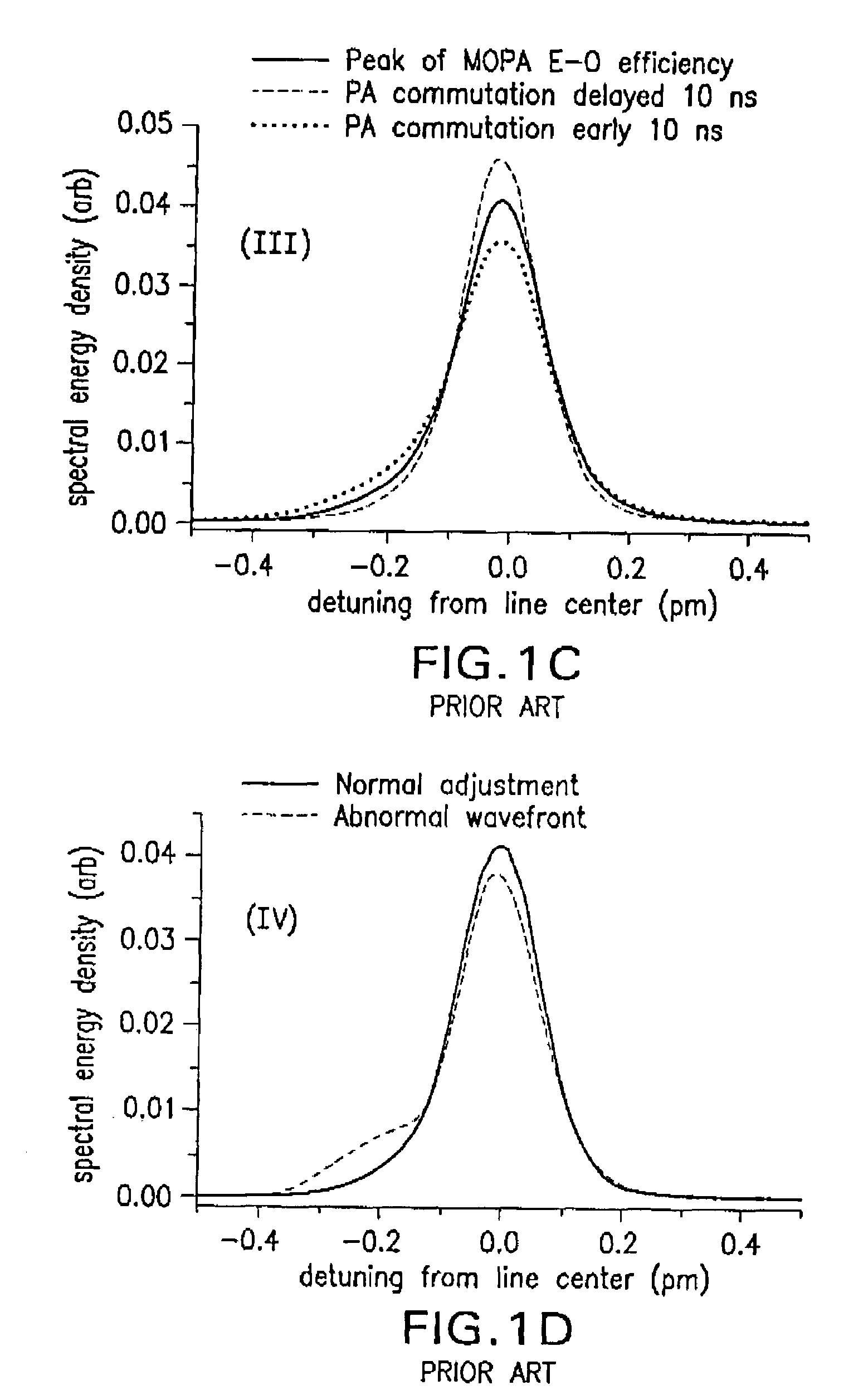Method and apparatus for bandwidth measurement and bandwidth parameter calculation for laser light
- Summary
- Abstract
- Description
- Claims
- Application Information
AI Technical Summary
Problems solved by technology
Method used
Image
Examples
example i
[0018 in FIG. 1A demonstrates the impact of greatly enriching the fluorine concentration of the laser gas in the master-oscillator of a MOPA or the gain medium of a single-oscillator, e.g., an ArF single chamber light source. With the addition of extra fluorine to the gas mixture at constant total pressure, the bandwidth increases. In these measurements the FWHM was found to stay constant within the precision of the measurement as fluorine was enriched to 13% above the initial concentration. The E95 was not constant, however, but increased by 18% for the same enrichment. This indicates, e.g., a significant change in the functional form of the spectrum, and not, e.g., simply a rescaling of the wavelength axis. Such a large over-enrichment of the laser gas mix is not typical, but could be representative of a hypothetical failure mode of a light source's internal controls, and in any event is indicative of symptomatic changes in bandwidth spectral shape with lesser increases in fluorin...
example ii
[0019 shown in FIG. 1B illustrates, e.g., the effect of an acoustic disturbance, e.g., timed to pass through the electrode gap during laser oscillation. As evidenced by the fact that the wings of the spectrum remain fixed while the central peak of the spectrum flattens and widens, the shape of the spectral profile is seen to change in response to such a so-called bandwidth resonance peak event. The effect of this shape change in the spectral shape is opposite to that of the previous example of FIG. 1A. In this case the FWHM bandwidth increased by 52% over the nominal value obtained away from the time-of-flight (“TOF”) resonance, otherwise known as acoustic resonance, while the E95 only rose 8% beyond the nominal value. The size of the TOF resonance effect can be greatly reduced with careful discharge chamber designs, but is present to some degree in all high-repetition rate systems and can occur randomly at differing operating laser discharge and output pulse repetition rates, tempe...
example iii
[0020 shown in FIG. 1C illustrates a change due to a very large static error in the relative timing of the discharge onset in the gain medium between two chambers of a MOPA light source. This phenomenon arises, e.g., because the spectral shape and bandwidth of the MO output is time-dependent. This behavior is therefore somewhat unique to MOPA systems (MOPO architectures have a further spectral complication due to gain competition between the injected and free-running modes of the power oscillator). In normal operation, the delay between firing of the two chambers is chosen to be that time τ0 corresponding to the peak of MOPA-system electrical-to-optical conversion efficiency. In this measurement of shape versus time delay, the bandwidth decreased by about 10% in FWHM and 25% in E95 when the delay was increased to τ0+10 ns. When the delay was decreased to τ0−10 ns, the bandwidth was seen to increase by approximately the same amount. Changing this delay can be used to control the band...
PUM
 Login to View More
Login to View More Abstract
Description
Claims
Application Information
 Login to View More
Login to View More - R&D
- Intellectual Property
- Life Sciences
- Materials
- Tech Scout
- Unparalleled Data Quality
- Higher Quality Content
- 60% Fewer Hallucinations
Browse by: Latest US Patents, China's latest patents, Technical Efficacy Thesaurus, Application Domain, Technology Topic, Popular Technical Reports.
© 2025 PatSnap. All rights reserved.Legal|Privacy policy|Modern Slavery Act Transparency Statement|Sitemap|About US| Contact US: help@patsnap.com



